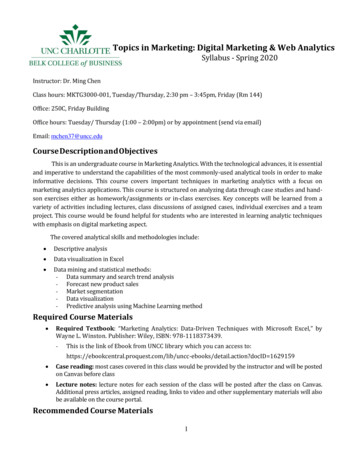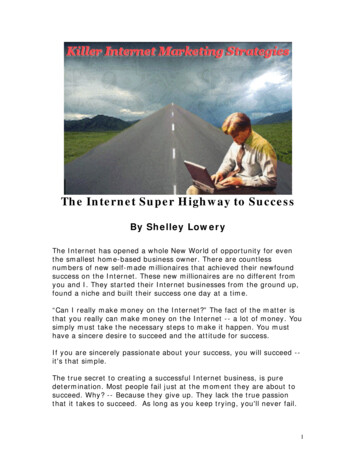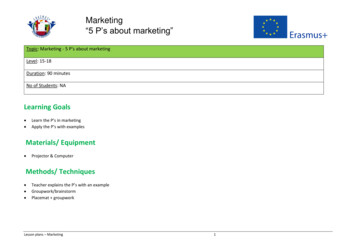
Transcription
IOSR Journal of Business and Management (IOSR-JBM)e-ISSN : 2278-487X, p-ISSN : 2319-7668, PP 67-74www.iosrjournals.orgMarketing InnovationMr.Chandrakhanthan, Mrs.Karthika.RAsso.Professor, M.A.M. B-SCHOOL, Siruganur.J, Asst.Professor, M.A.M. B-SCHOOL, SiruganurAbstractIn the present scenario innovation plays a vital role in the industry to sustain in the market. If thecompanies fail to adopt the new concepts may be they will loss the customers or market share. To survivein the market they have to focus on what is desirable to the users, what is viable in the market place andwhat is possible with technology. Organizational generally follow external and internal impetus as asources of innovation. Management guru Peter Drucker 1909 has identified four internal and threeexternal impetuses for innovation. Internal prompts include unexpected occurrences, incongruities,process needs, and industry or market changes.At the present scenario authenticity, net promoter scores, buzz tracking, From segmentation toinsights, Green, Grey, Co-creation, Experimentational budgets, The return of the soap, More CGAprevails in the market. Mr. Gerber referred to this marketing methodology as the E-myth which wascomprised of: innovation, quantification, orchestration, and documentation. The innovation has beenimplemented in many companies and they are running their business successfully. They are IBM, P&G,APPLE,Toyota Motors etc.To conclude if you’re trying to enhance your marketing program, or create one from scratch,keep this methodology in mind: innovation, quantification, orchestration, documentation. This process willensure constant growth and improvement in your marketing results Michael Fleischner, March 05, 2007.I.Marketing InnovationIntroductionThe term innovation derives from the Latin word innovatus, which is the noun form of innovare"to renew or change," stemming from in-"into" novus-"new". Although the term is broadly used,innovation generally refers to the creation of better or more effective products, processes, technologies, orideas that affect markets, governments, and society. Innovation differs from invention or renovation in thatinnovation generally signifies a substantial change compared to entirely new or incremental changes.Marketing innovations are aimed at better addressing customer needs, opening up new markets, ornewly positioning a firm’s product on the market, with the objective of increasing the firm’s sales.The distinguishing feature of a marketing innovation compared to other changes in a firm'smarketing instruments is the implementation of a marketing method not previously used by the firm. Itmust be part of a new marketing concept or strategy that represents a significant departure from the firm’sexisting marketing methods. The new marketing method can either be developed by the innovating firm oradopted from other firms or organizations. New marketing methods can be implemented for both new andexisting products.Importance of InnovationThe definition and description of innovation, as the Literature review shown, clearly indicate thatimpact of innovate thinking in the marketing activities is considerably high. Innovation and creativity, thecombination of originality, divergent thinking and risk taking, is expected element used for creatingguerrilla marketing campaigns. The necessity of applying innovate concepts in the marketing is supportedby findings of the Primary research where 53% of the respondents stated that their companies marketingNational Conference on “Innovative Business Practices in Technological Era”Erode Sengunthar Engineering College, Thudupathi, Erode67 Page
Marketing InnovationActivities are interesting, eye-catching and differ from the campaigns of competitors. Moreover,11% of the respondents describe their marketing activities as "unexpected, shocking and completelydifferent than what people would expect".The interest of respondents on innovation in their Internet marketing activities is expressed by 20out of 28 respondents who positively answered that they would like to have some unexpected andinteresting application on their website which would increase significantly the attention of the targetaudience. Therefore, as the research shows, use of innovation is necessary presumption for creating anyguerrilla marketing campaign both offline and onlineInnovation is the act of introducing something new or doing something in a different way.Innovation in business differs from creativity in that the latter is generally associated with the generation ofnew ideas. In contrast, innovation refers to taking those new ideas and actually implementing them in themarketplace. Thus, creativity is simply one element of the innovation process through which new ideaslead to new products, procedures, or services. Business scholars often attribute company success toinnovation. Because of growing international competition, innovation became even more vital forcompanies toward the end of the 20th century.Innovation usually results from trial-and-error experimentation and sometimes occurs incidentallywhere researchers produce something other than what they intended. Nevertheless, because of the growthof and accessibility to knowledge and information through the technology and information revolutions,researchers of the late 20th century generally could move from ideas to innovations much more quicklythan their predecessors. A confluence of factors contributes to innovation in the business setting, includingthe research environment, market need, company strategy, and company resources.II.History Of Innovation In BusinessWhile innovation has existed as long as the species has, early innovations penetrated society andbecame established more slowly. For example, printing technology, various transportation innovations, andthe use of gunpowder took centuries to reach most levels of society and become part of everyday life,according to Basil Blackwell and Samuel Eilon, authors of The Global Challenge of Innovation.The penetration and acceptance of various innovations began to accelerate with the gradualcollaboration and cooperation of science and assorted crafts and industries, especially in the 19th century.The partnership between science and industry allowed scientists to produce practical, reproducibletechnologies, which businesses could reasonably afford. Because of this collaboration, innovation grewquickly.Despite the partnership, however, science and businesses still remained separate entities.Researchers worked either independently or as members of companies that specialized in developing,producing, and marketing innovations during this period. Consequently, many of these innovations failedto make it to the market.Companies, however—especially power, chemical, and communications companies—begancreating in-house research and development divisions early in the 20th century. In addition, theyenhanced and marketed the innovations of others, breaking down the barrier between innovator andNational Conference on “Innovative Business Practices in Technological Era”Erode Sengunthar Engineering College, Thudupathi, Erode68 Page
Marketing Innovationcompany. As a result, companies, not individuals, began controlling the patents to new inventions.Furthermore, teams of company researchers, not lone inventors, became the primary innovators.III.Sources Of InnovationInnovation is occasionally the result of a stroke of genius. More often, though, it occurs inresponse to a problem or opportunity that arises either inside or outside of an organization. Managementguru Peter Drucker (1909) has identified four internal and three external impetuses for innovation. Internalprompts include unexpected occurrences, incongruities, process needs, and industry or market changes.Internal Impetuses.Unexpected occurrences include mishaps, such as a failed product introduction. It is oftenthrough such unexpected failures (or successes) that new ideas are born from new information brought tolight. For instance, Ford's failed Edsel gave the company new information about marketing that allowed itto achieve stellar gains with succeeding products.Incongruities result from a difference in a companies or industry's perception and reality. Forexample, although the demand for steel continued to grow between 1950 and 1970, profits in the steelindustry fell. This incongruity caused some innovators to develop the steel minimill, a less expensivemethod of making steel that was also more conducive to changing market demands.Innovations inspired by process needs are those created to support some other product or process.For example, advertising was introduced to make mass-produced newspapers possible. Newspaperpublishers devised ads to cover the expense of printing the newspapers on the new equipment that madesuch printing possible.Industry and market changes, the fourth internal impetus to innovate, often result in the rise(and decline) of successful innovators. For example, innovation and business savvy allowed InternationalBusiness Machines Corp. (IBM) to effectively dominate the computer industry during the 1970s and early1980s. It failed, however, to respond to a market switch during the 1980s from mainframes to smallercomputer systems, particularly workstations and personal computer networks. As a result, IBM's share ofthe computer market plummeted and profits plunged as more innovative newcomers emerged.External Impetuses.External impetuses to innovate include demographic changes, shifts in perception, and newknowledge. Demographic changes affect all aspects of business. For instance, an influx of Asian andMexican immigrants into the United States has created new market niches for companies. Likewise, anincrease in the level of education of Americans has resulted in a dearth of qualified workers for some lowpaying jobs, causing many companies to develop new automation techniques.Changes in perception also open the door to innovation. For example, despite the fact that healthcare in the United States has continually gotten better and more accessible, people have becomeincreasingly concerned about their health and the need for better and more accessible care. This change inperception has generated a huge market for health magazines, vitamin supplements, and exerciseequipment.Finally, one of the strongest external impetuses for innovation is new knowledge, or technology.When a new technology emerges, innovative companies can profit by exploiting it in new applications andmarkets. For example, the invention of Kevlar, a synthetic material, has spawned thousands of new productinnovations, ranging from improved canoes and bulletproof vests to better tires and luggage.IV.Innovation StrategiesTwo types of strategies for innovation in business are internal and market-based approaches.Internal strategies include programs and initiatives implemented by companies to foster a creative andinnovative environment, whereas market-based strategies—such as the leader, quick follow, and slowfollow strategies—refer to different approaches to delivering innovations to the market. Internal Innovation Strategies.Internal strategies usually seek to develop and nurture the attributes of innovative corporations,such as prioritizing and encouraging innovation. Specific approaches to encouraging innovation differ bycompany and industry. For example, an integral aspect of Dow Corning Inc.'s strategy is to form "researchNational Conference on “Innovative Business Practices in Technological Era”Erode Sengunthar Engineering College, Thudupathi, Erode69 Page
Marketing Innovationpartnerships" with its customers that solicit creative input from consumers and help the company benefitfrom new market opportunities. Other companies that employ customer-partnering programs include Black& Decker Corp. and General Electric.One of the most innovative firms in the United States, 3M Company, sustains its creativeenvironment by following a set of simple rules. By keeping its divisions small, division managers know thefirst names of all their subordinates, and, moreover, the company splits up divisions before their salessurpass 250 million to 300 million. It tolerates failure by promoting risk taking and experimentation. Infact, divisions must derive at least 25 percent of their profits from products developed during the past fiveyears.One of the most renowned strategies to generate innovation in organizations is the "Office ofInnovation" model developed by Eastman Kodak Company in the late 1970s. It has since beenimplemented by several leading organizations, including Amoco Corp., Union Carbide, the U.S. Air Force,and Bell Canada. The Office of Innovation provides a mechanism for drawing people together tobrainstorm on ideas that may not even be related to their departments or expertise. In fact, its chief benefitis that it promotes cross-fertilization and free-flow of ideas within a company.Although implementation varies, the model prescribes the use of a decentralized network ofindividual offices located in different functional areas, such as marketing, finance, and production. Staffmembers are encouraged to seek employees in other sectors who will come to the office and providefeedback on new ideas. Market-Based Strategies.Even companies with the most innovative organizational environments will languish if they fail toeffectively market their innovations. For example, just because a firm improves its product doesn't meanthat it should necessarily take the improvement to the market. From a strategic standpoint, the companycould lose money if it has invested a lot of resources in marketing the original product because theimproved version might cannibalize sales.Although there are a number of product- and industry-specific strategies that companies mayemploy to promote their innovations, three of the most common market-based innovation strategies includethe leader, quick follow, and slow follow (or no follow.The leadership strategy, however, also may provide a variety of different benefits. For instance,companies often introduce an innovation to an existing product or service, calling it "new" or "improved,"to breathe new life into it. Or they may bring out an improved product to discourage the competition fromtrying to steal market share, or to "leapfrog" their competitors. In the case of completely new products orideas, a company may introduce the innovation in an effort to establish market dominance and attainleadership status.The quick-follow strategy is often used by established competitors that already lead an industryor market niche. Rather than assume the risk inherent to the leadership strategy, the company will simplywait for one of its competitors to introduce an innovation. Shortly thereafter, the company will follow theleader with a substitute or improvement of the innovation. Quick followers are usually relatively sure oftheir ability to crush the competition with their established reputation and marketing and distributionchannels.A company that adopts a slow- or no-follow strategy may do so for a number of reasons. It mayfeel that existing competitive pressures or lackluster market growth make an investment in following aninnovation unappealing. Or, the company may realize that it simply lacks the resources or technologynecessary to compete with the new innovation. Some companies refuse to introduce or adopt an innovationbecause they fear that they will lose customers.V.Trends In Marketing Innovation:Authenticity:Authenticity, honesty, ‘realness’ should have been at the top of this list for the past 10 years – butit seems as if it is actually breaking through now. Too many great examples of how companies enhancedtheir image and standing with either the general public or a relevant group of advocates have emanatedrecently – Scobleizer has probably generated billions worth of goodwill for Microsoft.Net Promoter ScoresNational Conference on “Innovative Business Practices in Technological Era”Erode Sengunthar Engineering College, Thudupathi, Erode70 Page
Marketing InnovationSell your shares in market research agencies – their extensive research methods will go the way ofthe dinosaurs. Turns out, it all comes down to one question: "On a scale of 0 to 10, how likely are you torecommend brand/product X to someone else?" As the results of this research can be directly tied torevenue growth, instead of intangible (and not-boardroom safe) fuzzies like brand recognition, watch thecorporate world being taken by storm by NPS, following the likes of GE and Philips.Buzz tracking What’s being said about me? Why is nobody talking about me? These are becoming core issuesfor every company. With the advent of ever better tracking tools for online conversations, it’s becomingindispensable to listen into those conversations, be it to monitor bad things happening out there so you canjump in and call corporate 911, or to find out that nobody really cares about you (which is actually evenworse).From segmentation to insights‘Hey Cathy, I know you have a long distance relationship and are working only part-time to carefor your newborn baby (which by the way has done it for your disposable income, for good), but I will stilltreat you the same as two years ago, when you were a job-starting, free-spending party animal. After all,you are still a 25-29 year old highly educated urban single female, aren’t you?’GreenIt may be a cynical choice by many companies, but green awareness is the trend-du-jour. If evenWal-Mart is starting to promote eco-friendliness, where will it stop? As there is a lot of revenue waiting inthis market – be it from selling eco-friendly goods at marked-up margins, or actually providing ecotechnology, this one won't go away.GreyMarketers the world over are waking up to the fact that the older demographic is a majoropportunity – and needs to be addressed in a different way then the 18-34 year olds. Mind you, differentdoesn’t mean being patronizing and playing on old age. We’re talking people who went to Woodstock anddid all kinds of naughty things in their youth – don’t talk to them as if they are senile.Co-creationThe lazy developers dream – let your customers come up with your products for you. The powerof harnessing your customers’ insights is amazing. Once again you are connecting directly to the insights,wishes and beliefs of your customers, ensuring that you will hit a home-run with the rest of the world too.Experimentational budgetsFollowing the leaders like Unilever, P&G and Heineken, marketers realize that they will have toset a portion of their marketing budgets aside for well structured experiments. Developments in the digitaldomain are so fast and furious it’s not always possible to wait for full understanding. By experimenting ina controlled way companies can get insights at very attractive cost – and sometimes even strike gold.The Return of the SoapAs the consumer’s aversion to traditional 30” spots is starting to hurt, TV channels and advertisersalike have to look for different models. Product placement and branded entertainment are starting to takeup a serious position in their portfolios. A major advantage is that the convergence of TV and online isalmost built into this model, as there are far less objections to the re-distribution of branded contentthroughout the internet then with traditional advertising-funded models.More CGANot only developers have their lazy-dream, marketers too: Consumer Generated Advertising. Letyour customers not only be your Promoters, but actually make your advertising for you. As this advertisingwill always be based on what they REALLY love about you, it’s sure to strike home with other consumers.Marketing Innovation: How To Improve Marketing RoiNational Conference on “Innovative Business Practices in Technological Era”Erode Sengunthar Engineering College, Thudupathi, Erode71 Page
Marketing InnovationThere are
marketing instruments is the implementation of a marketing method not previously used by the firm. It . Innovation is occasionally the result of a stroke of genius. More often, though, it occurs in . causing many companies to develop new automation techniques. Changes in perception also open the door to innovation. For example, despite the .











